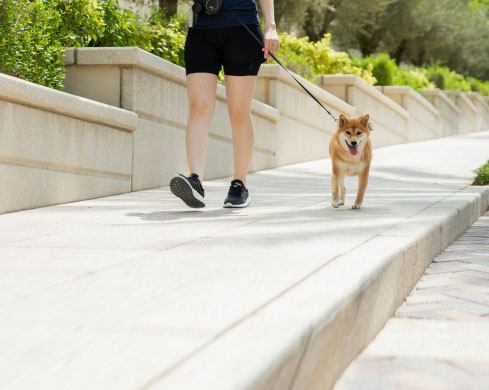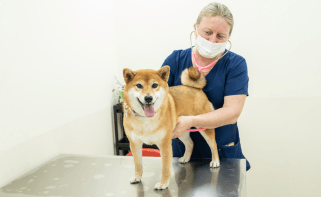Seasonal Safety Hacks

If you have to decrease the number or duration of your If you have to decrease the number or duration of your walks or daily exercise, you may need to decrease your dog’s food intake slightly to ensure it doesn’t gain weight in the summer months.
As summer temperatures continue to soar across the UAE, pet owners must take extra precautions to ensure their pets are protected from the heat. It’s important to spot the signs of heatstroke, which can cause illness or even death if not treated quickly.
Hotter weather, however, does not mean that your pet must stay inside all the time over the summer months, as there are more suitable times of the day to exercise your pet outdoors. You can also enjoy similar activities in doors to keep your pet active if the weather is too hot, and summer is a perfect time for pet owners to concentrate on training techniques and methods, with more time spent inside together.
Here are some tips you can follow to make high temperatures as comfortable and safe as possible.
Being active
Daily one-on-one interaction is essential for dogs to keep them active and mentally stimulated. During the summer months, this can be done indoors. However if it is cool enough, the best times to play outside and walk your dog are first thing in the morning, before 8am if possible, and after 6pm.
Humidity levels can still be high even after sunset, so walking your dog as late as possible is recommended. Pet owners should be aware of the temperature of the surface their pet is walking on, and the best way to check this is to place the back of your hand or foot on the surface for a minimum of ten seconds to ensure it is safe. If the temperature is too hot for us, it is too hot for our pets. The type of surface is also important to consider, as concrete retains more heat, often 15 degrees Celsius more, than other surfaces, such as grass. Dogs have sweat glands on their paw pads, and if the surface is too hot, it can result in burnt paws and their inability to lose heat and regulate their body temperature, which can result in heatstroke.

Dealing with heatstroke
Heatstroke is an emergency for pets, and seeking treatment from a qualified, trusted vet is critical. Your vet will know the correct form of treatment to administer, such as low-sodium and potassium-rich fluids.
Signs of heatstroke in pets include strained panting, agitated breathing, excessive drooling or salivating, restlessness, increased heart rate, vomiting, and diarrhoea. If these symptoms are evident at any time, inside or outside the house, it is vital to contact your trusted veterinarian and book an appointment as soon as possible.
Many veterinarians operate with 24-hour emergency services, including the British Veterinary Hospital and Marina Vet Clinic, to ensure that your pet receives the medical attention they require immediately and do not face a delay that could further harm their health.
All dog owners should also keep a wet, frozen towel in the freezer to help with suspected symptoms of heatstroke. A cold towel will provide your pet with some relief while you wait for the appointment.
Indoor activities
If it’s just too hot outside, there are lots of ways you can exercise and mentally stimulate your pet indoors. To provide an instant cooled way for your pets to play, simply take a toy that has been placed in the freezer for a few hours, such as a ball or rope chew, and let your pet play as normal. Dogs love frozen balloons filled with water and small amounts of chicken stock to entice them to play and exercise indoors.
Supervised water play is another way to keep your dog’s body temperature at a healthy and optimum level during summer. Larger breeds of dogs will enjoy a paddling pool filled with cold water in a garden, while smaller breeds and puppies will benefit from playing in a large wash basin or bath.
If you have to decrease the number or duration of your walks or daily exercise, you may need to decrease your dog’s food intake slightly to ensure it doesn’t gain weight in the summer months.
Before making any changes to your pet’s diet, consult your vet, who will ensure you do this safely and your beloved pet continues to get all of the nutrition it needs to stay fit and healthy.
Cat care
It is not just dogs that can suffer from heatstroke and the effects of hotter weather. Cats are typically adaptive to the heat and will not spend time outside if it is too hot. However, they can suffer from burnt paw pads, like dogs, if a surface is too hot, and it is important to seek the same veterinary care should this or any signs of heatstroke occur.
Cats, like dogs, should have shaded grass areas available for play and exercise, and fluffier, short-nosed breeds should be exercised indoors as much as possible. As homes can heat up as temperatures rise outside, keeping the air conditioning set to a comfortable and safe temperature between 22 and 24 degrees Celsius is best to ensure your pets remain cool.
Pets are family members, and their safety and health are important throughout the year. Summer can be difficult for some pets and pet owners, but following proper pet-care advice can ensure your pet’s well-being. Exercising your pet at the coolest times of day, engaging in more home-based play activities if it is too hot outside, having fresh water available at all times and being able to identify the symptoms of heatstroke and seeking veterinary care if in doubt are ways in which you can protect your pet throughout summer.
After growing up in the Middle East, Dr Sara Elliott completed her veterinary degree at the University of Cambridge, qualifying as the youngest ever veterinary surgeon from Cambridge. After practising on the Isle of Wight, she returned to her roots in the Middle East to work for an established practice, then as a joint owner of a veterinary clinic in Dubai. She operates the first fully licensed veterinary hospital in the UAE.
